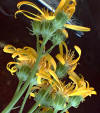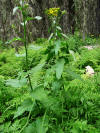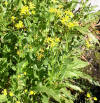|
Senecio canus Rocky Mts. —Colorado: Continental Divide, Chaffee Co., Gunnison Natl. Forest just E of Monarch Pass, ~ 2 miles north off Hwy 50 on Forest Road 237; 38º30'24.5", 106º19’41.0”, 3400 m. Clearings in spruce-fir forest. SPJ-16404, 1 Aug 2008
|
  Senecio clarkianus Greenhorn Mts. Kern
Co., CA. East slope of Sunday Peak along Forest Service Road
|
Senecio flaccidus var. douglasii West side of Greenhorn
Summit, Hwy 155, Greenhorn Range, Kern Co., CA
|
|
|
Senecio flaccidus var. flaccidus
|
Senecio flaccidus var. douglasii |
||
|
Senecio lugens (with Veratrum
californicum) |
|||
|
Idaho: North-central, Clearwater Natl. For., Eldorado Creek near jct. with Dollar Creek, 46º17.964, 115º38.776, elev. 3,540 ft, wetland prairie with dominant Veratrum californicum surrounded by forest of Englemann spruce, subalpine fir, western red cedar, lodgepole pine, western larch. 26 July 2011 |
Senecio triangularis |
||
|
Trees and Shrubs of Kern County (Sep 2012) Senecio: Key to varieties of Senecio flaccidus Plants with gray hairs............................................................................... var. douglasii Plants green without hairs...................................................................... var. monoensis
Senecio flaccidus Lessing 1830 var. douglasii (Senecio douglasii DeCandolle 1838) B. Turner & T. Barkley 1990; includes S. douglassi var. tularensis Munz 1958]. Butterweed. Subshrub, with one or more erect whitish green stems, branching mostly above base, the branches ascending then erect, all reaching about the same height (forming a flat top) to 1.5 m; leaves alternate, pinnately divided into long thread-like segments; flowers Apr–Oct, yellow, the heads numerous near ends of stems on short on short branchlets, rays ~13; involucral bracts in one single series subtended by short bractlets at base, the main bracts strap-like, abrupt tapered to a black tip; cypselae with a short pericarpium and long white capillary bristles. Deserts, woodlands and chaparral below 6,000 ft; Utah to Sonora, Mexico, west to southern California and Baja California to Sierra Juárez. Type from California. Kern Co.: “Common in cismontane Upper Sonoran associations, especially in sandy or light soils. In years with late wet springs the pants are often infested with mildew” (Twisselmann), 463–1,823 m (CCH) Senecio flaccidus Lessing var. flaccidus occurs mainly in the Rocky Mountains to Kansas, Oklahoma and Mexico. CCH specimens (SD)—collected from near Hobo Hot Springs (F. Gander, 7 Jul 1941) and from near Lebec (D. Howe, 5 Oct 1941), identified var. monoensis, probably belong to var. douglasii. Senecio flaccidus Lessing var. monoensis (Senecio monoensis Greene 1906) B. Turner & T. Barkley 1990 [Senecio douglassi var. monoensis Jepson 1925]. Differs in plants being mostly glabrous. Eastern Sierra Nevada, Transverse and Peninsular Ranges, east to Utah, Texas and south into to Baja California to Miller’s Landing. Type from the White Mts., CA. Kern Co.: “A rather indistinct glabrous form that replaces the typical variety in the pinyon woodland on the east slopes of the Piute Mountains and in the desert-facing slopes and canyons of the Sierra Nevada north of Walker Pass” (Twisselmann). CCH includes specimens from Owens Peak region, Short Canyon, Buena Vista Canyon, east slope of Walker Pass, and Horse Canyon in the Scodie Mts., 1,220–1,829 m.
References on Biological Activity in Senecio Anke S., D. Niemüller, S. Moll, R. Hänsch and D. Ober. 2004. Polyphyletic origin of pyrrolizidine alkaloids within the Asteraceae. Evidence from differential tissue expression of homospermidine synthase. Plant Physiol. 136(4): 4037–4047. “The evolution of pathways within plant secondary metabolism has been studied by using the pyrrolizidine alkaloids (PAs) as a model system. PAs are constitutively produced by plants as a defense against herbivores. The occurrence of PAs is restricted to certain unrelated families within the angiosperms. Homospermidine synthase (HSS), the first specific enzyme in the biosynthesis of the necine base moiety of PAs, was originally recruited from deoxyhypusine synthase, an enzyme involved in the posttranslational activation of the eukaryotic initiation factor 5A. Recently, this gene recruitment has been shown to have occurred several times independently within the angiosperms and even twice within the Asteraceae. Here, we demonstrate that, within these two PA-producing tribes of the Asteraceae, namely Senecioneae and Eupatorieae, HSS is expressed differently despite catalyzing the same step in PA biosynthesis. Within Eupatorium cannabinum, HSS is expressed uniformly in all cells of the root cortex parenchyma, but not within the endodermis and exodermis. Within Senecio vernalis, HSS expression has been previously identified in groups of specialized cells of the endodermis and the adjacent root cortex parenchyma. This expression pattern was confirmed for Senecio jacobaea as well. Furthermore, the expression of HSS in E. cannabinum is dependent on the development of the plant, suggesting a close linkage to plant growth.” Conforti F, Loizzo MR, Statti GA, Houghton PJ, Menichini F. 2006. Biological properties of different extracts of two Senecio species. Int. J. Food Sci. Nutr. 57(1-2): 1–8. “This study reports on the antioxidant, anti-diabetic and cytotoxic properties of different extracts of two Senecio species, Senecio vulgaris and Senecio inaequidens. Leaves of the latter are used as food in specific populations of Southern of Africa. Both investigated species of Senecio were found to possess different biological activities. S. inaequidens extracts possess a greater antioxidant activity in comparison with S. vulgaris. Highly significant and dose-dependent performance was obtained with the methanolic and dichloromethane extracts of S. vulgaris and the n-hexane extract of S. inaequidens regarding cytotoxic activity on cancer cell lines, while none of the extracts demonstrated activity on normal cell line MRC-5. Both Senecio species also show appreciable alpha-amylase inhibition, particularly the methanolic and dichloromethane extracts, and this may confer anti-diabetic properties on the extract. Loizzo M. R., R. Tundis, G. A. Statti and F. Menichini. 2007. Jacaranone: a cytotoxic constituent from Senecio ambiguus subsp. ambiguus (biv.) DC. against renal adenocarcinoma ACHN and prostate carcinoma LNCaP cells. Arch. Pharm. Res. 30(6): 701–707. “Senecio ambiguus subsp. ambiguus (Biv.) DC. extracts were able to inhibit the in vitro proliferation of renal cell adenocarcinoma ACHN and hormone dependent prostate carcinoma LNCaP. The potential cytotoxic property of the plant was revealed by the methanolic extract action against LNCaP (IC50 of 5.51 microg/mL) and ACHN (IC50 of 38.95 microg/mL). The most potent cytotoxic activity (IC50 of 5.34 microg/mL against the prostate carcinoma cell line) was exerted by the dichloromethane extract. Through bioassay-guided fractionation of the dichloromethane extract jacaranone was isolated as the major active constituent. This quinoid showed a very strong activity against ACHN and LNcaP with IC50 of 4.32 and 7.39 microg/mL, respectively. Its structure was established by GC/MS and NMR analysis. The n-hexane extract showed an interesting inhibition on the proliferation of tumor cell lines an IC50 value of 5.23 microg/mL against LNCaP. Three compounds identified in the n-hexane extract such as nerolidol, a-humulene and g-tocopherol were found to be active aginst LNCAP with IC50 values ranged from 11.24 to 15.56 microg/mL. Neuman M. G., A. Y. Jia and V. Steenkamp. 2007. Senecio latifolius induces in vitro hepatocytotoxicity in a human cell line. Can. J. Physiol. Pharmacol. 85(11): 1063–1075. “The objectives of this study were twofold: (i) to determine the mechanism(s) of Senecio-induced toxicity in human hepatoblastoma cells (HepG2) in vitro and whether such toxicity could be prevented using N-acetyl-cysteine (NAC), and (ii) to evaluate whether caspases are involved in Senecio-induced apoptosis. Cells were treated with aqueous extracts of Senecio (10 mg.mL-1) with and without NAC. Cytotoxicity was determined by using the MTT assay. Total glutathione (GSH) was measured by using the Tietze assay. Cells were also treated with aqueous extracts of Senecio in the presence or absence of 50 mumol/L caspase-3 inhibitor (IDN) for 24 h. Apoptosis was determined by transmission electron microscopy, and DNA fragmentation was determined by ELISA and terminal dUTP nick-end labelling (TUNEL). Senecio produced cytotoxicity and depleted GSH in a concentration- and time-dependent manner. A significant depletion in GSH was observed after 15 min (p < 0.001 vs. control), whereas significant cytotoxicity was only observed after 3 h (p < 0.001 vs. control). Treatment with NAC prevented Senecio-induced GSH depletion and resulted in a significant decrease in Senecio-induced cytotoxicity (p < 0.001 vs. NAC-untreated cells). Treatment with Senecio for 24 h resulted in 22% +/- 2.5% (p < 0.001) apoptosis (vs. control). Pretreatment with 50 mumol caspase inhibitor reduced Senecio-induced apoptosis significantly (vs. non-exposed to IDN) (12% +/- 1.5%; p < 0.05). Our results suggest the mechanism of Senecio-induced cytotoxicity in HepG2 cells in vitro involves depletion of cellular GSH. Cytotoxicity is reduced by supplementation with NAC, which thus prevents GSH depletion. Caspase activation is involved in Senecio-induced apoptosis.” Pelser P. B., H. de Vos, C. Theuring, T. Beuerle, K. Vrieling and T. Hartmann. 2005. Frequent gain and loss of pyrrolizidine alkaloids in the evolution of Senecio section Jacobaea (Asteraceae). Phytochemistry 66(11): 1285–1295. “Pyrrolizidine alkaloids (PAs) of the macrocyclic senecionine type are secondary metabolites characteristic for most species of the genus Senecio (Asteraceae). These PAs are deterrent and toxic to most vertebrates and insects and provide plants with a chemical defense against herbivores. We studied the PA composition of 24 out of 26 species of Senecio section Jacobaea using GC-MS. The PA profiles of eight of these species have not been studied before and additional PAs were identified for most other species that were included in previous studies. With one exception (senecivernine) all 26 PAs identified in sect. Jacobaea can be regarded as derivatives of the biosynthetic backbone structure senecionine. Based on the PA profiles of the species of sect. Jacobaea and the results of previous tracer studies, we constructed two hypothetical biosynthetic scenarios of senecionine diversification. Both scenarios contain two major reactions: the conversion of the necine base moiety retronecine into the otonecine moiety and site-specific epoxidations within the necic acid moiety. Further reactions are site-specific hydroxylations, sometimes followed by O-acetylations, site-specific dehydrogenations, E, Z-isomerizations, and epoxide hydrolysis and chlorolysis. The GC-MS data and both biosynthetic scenarios were subsequently used to study the evolution of PA formation in sect. Jacobaea by reconstructing the evolutionary history of qualitative PA variation in this section. This was achieved by optimizing additive presence/absence data of PAs and types of enzymatic conversions on a maximum parsimony cladogram of section Jacobaea inferred from DNA sequence and morphological data. Besides showing large intra- and interspecific variation, PA distribution appears to be largely incidental within the whole clade. These results together with the finding that all but one of the PAs identified in sect. Jacobaea are also present in species of other sections of Senecio indicate that differences in PA profiles in Senecio can not be explained by the gain and loss of PA specific genes, but rather by a transient switch-off and switch-on of the expression of genes encoding PA pathway-specific enzymes.” Toma W., J. R. Trigo, A. C. de Paula and A. R. Brito. 2004. Preventive activity of pyrrolizidine alkaloids from Senecio brasiliensis (Asteraceae) on gastric and duodenal induced ulcer on mice and rats. J. Ethnopharmacol. 95(2-3): 345–351. “The alkaloid extract of Senecio brasiliensis inflorescences contain a mixture of the pyrrolizidine alkaloids (PA) senecionine, integerrimine, retrorsine, usaramine and seneciphylline. We evaluated this PA mixture on preventive antiulcerogenic effects on standard rodent models of induced gastric and duodenal ulcers. In the HCl/ethanol, indomethacin-bethanechol and hypothermic-restraint-induced gastric ulcer, the lesion was significantly inhibited by PA (p.o.) (p < 0.001). In the pylorus-ligature, PA (i.d.), significantly increased the gastric juice content and the pH values and decreased the acid output. In the cysteamine induced duodenal ulcers, PA (p.o.) showed significant inhibition (p < 0.001) of the duodenal lesions when compared to the respective control. The levels of the somatostatin hormone in the blood samples of animals pre-treated with the PA (12.5 mg/kg) and the free mucus and prostaglandin synthesis also increased (p < 0.001) after administration of PA extract (p.o.). The results suggested that the PA extract from Senecio brasiliensis inflorescences presents a significant anti-ulcer effect in the selected ulcer models. The mechanism involved with the action of the PA extract is the cytoprotection. Additional studies are in progress to determine other possible mechanisms involved with effect of the PA as anti-ulcer agents.” Tundis R., M. R. Loizzo, G. A. Statti, P. J. Houghton, A. Miljkovic-Brake and F. Menichini. 2007. In vitro hypoglycemic and antimicrobial activities of Senecio leucanthemifolius Poiret. Nat. Prod. Res. 21(5): 396–400. “This study reports on the alpha-amylase inhibitory and antimicrobial activities of Senecio leucanthemifolius Poiret. Extracts of S. leucanthemifolius were tested for their antimicrobial and antifungal activities against seven different pathogenic microorganisms using the microdilution technique. The ethyl acetate extract exhibited a strong antibiotic activity against Staphylococcus aureus with a MIC value of 31.25 microg mL(-1), while the n-hexane extract showed a significant activity against dermatophytic fungi. S. leucanthemifolius extracts were tested also for their potential hypoglycemic activity through the in vitro inhibition of alpha-amylase. The dichloromethane extract inhibited alpha-amylase with a value of 56.6% at 0.05 mg mL(-1) and the n-butanol extract showed a value of 89.2% at 1 mg mL(-1).”
|
|||








